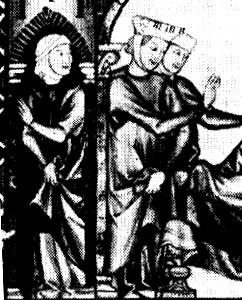
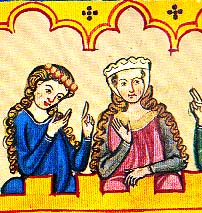
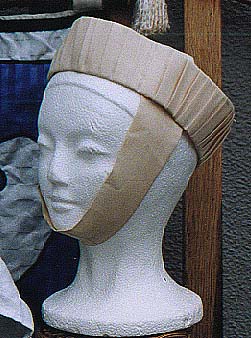
by Cynthia du Pre Argent



First picture is from a book commissioned by Alphonse the Wise in
around 1260; the second is from the Manesse Codex, in the very early 1300s.
The third picture is of a hat that I made, which is falling off the model
head because it is too large for the head, but the right size for me!
These hats are lightweight, easy to make, and look good on anyone
with hair shoulder-length or longer. This page discusses one way
to make them, and another method which might solve some remaining questions.
As with all hats from the middle ages, we have no extant examples, so conclusions of method and materials are all taken from contemporary illustrations. Your conclusions may be different than mine, and that's OK.
There are a few generalizations that can be made about these hats: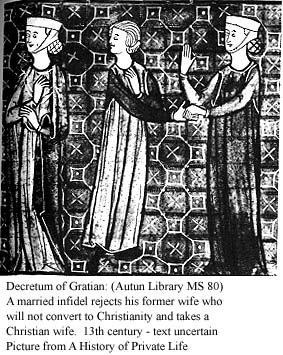
I believe that most of them were open on the top. There is
an effigy at the Cloisters in New York that clearly shows the top of the
woman's head; you can see the band, and her hair, inside the 'bowl' of
the hat.
Most folks call this arrangement a barbette (strap) and fillet (hat). I'll use those terms.
First, cut out a 1/4 ring of buckram. This will get you a
nice, smooth outward flare that is not too extreme. To make the 1/4
ring:

To cover with pleated fabric, cut out a strip of fabric just over two times longer than your head measurement, and twice as wide as your fillet is tall, plus seam allowance. Iron this into pleats before applying to the fillet.
To apply the pleated fabric to the fillet, pin the pleats onto the middle
of the fillet's band, all the way around. Then you can carefully
fold the pleated fabric over the top and bottom. The pleats may well
expand or contract a bit due to the angle of the fillet. This is
ok; you'll be ironing them again when you're done. Pin securely,
and then baste the covering together on the inside of the fillet. 
Now all you need is a band for holding it on. Measure around your head as if you were wearing a kerchief, making sure to go over the top of your head, rather than around your face. Cut your fabric this long, plus 3" and as wide as you like -- I suggest 3" wide, which you then sew into a tube, and turn inside out and press.
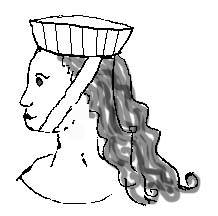 To
wear, wrap the barbette from your chin to the top of your head, and pin
with a straight pin. This should be fairly snug; it will loosen a
bit once pinned. Then set the fillet on your head, making certain
that it is horizontal, not falling off the back of your head. Pin
the fillet to the band with two straight pins.
To
wear, wrap the barbette from your chin to the top of your head, and pin
with a straight pin. This should be fairly snug; it will loosen a
bit once pinned. Then set the fillet on your head, making certain
that it is horizontal, not falling off the back of your head. Pin
the fillet to the band with two straight pins.
Voila! You're done!
If you like the Manesse look, the night before the event, braid
your hair in at least two ponytails, as high on your head as you can get
them. Leave the braids in and drying until you get to the event.
If you don't want the pleats, simply made a cover for the buckram when it's still flat, out of two quarter-rings of covering fabric, and sew down.
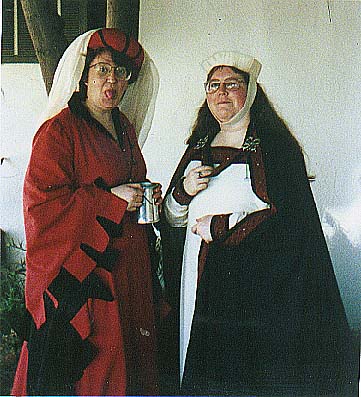 This is the only picture I have of me in this hat (on the right) and that's
my sister in red.
This is the only picture I have of me in this hat (on the right) and that's
my sister in red.
I tried to get clever recently, and sewed my covering fabric into a tube and then slipped it over the buckram and pleated it by hand. It took forever. Pleat the fabric when it's flat and manipulate it to cover the buckram and then sew.
A way to get both the appearance of pleats and the scalloped edge would be to make the hat as if it really were a "coffee filter hat" (this is the nickname that many costumers give these hats.) Think of a standard basket-style coffee filter. It's made out of a disk of paper, which has then been fluted at the top and sides.
I tried this recently with a piece of regular buckram, and then tried
it with buckram covered by silk-like fabric. It worked very well.
Here's a picture of the buckram after
it was cut, gathered up on the outside edge, put over the end of a bowl,
spritzed with water (to set the starch) and then left to dry in that shape.
Here's the same buckram on a headform,
after the retaining thread was taken out. You can see tha this would
make a nice hat. Mine with the fabric turned out well, except I wasn't
paying attention, and used blue ballpoint to mark the buckram, which bled
through mightily when I got it wet. Here is a picture of the finished
hat from above, and one from level with
the head.
| All material (c) 1999-2000 Cynthia Virtue | Email Author with comments |
| Back to Virtue Ventures Main Page | Back to Article Index |